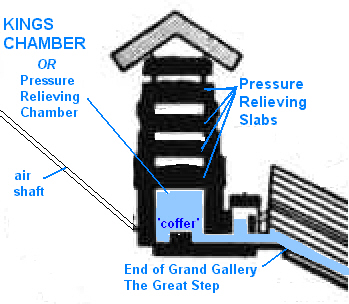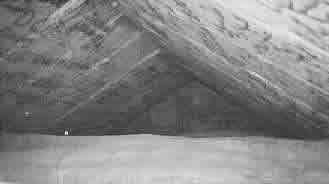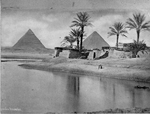Into the Grand Gallery and Kings Chamber
chambers of the Pyramid as known to date.
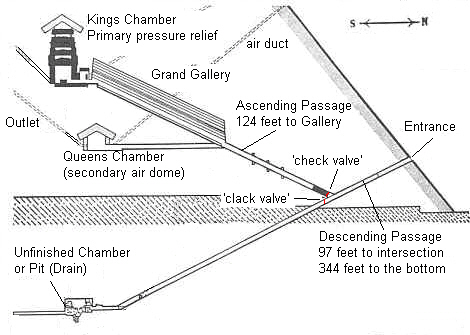
The Grand Gallery
 © 2013 Atlas Publications
© 2013 Atlas Publications

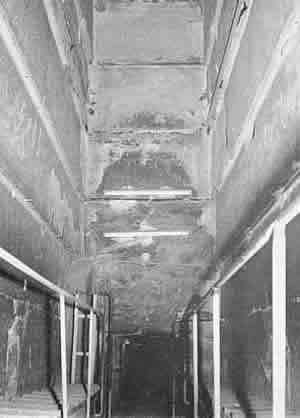
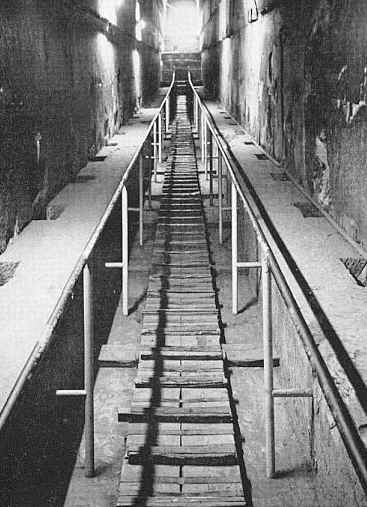 Following the ascending passage, up at its 26-degree angle, after 124 feet, we finally arrive at a large
open space. This is known as the 'Grand Gallery', unique to the Great Pyramid of Giza, the only one to have
a magnificent grand gallery in its ascending system. It is a hall 153 feet long and 7 feet wide at the floor
level, and about 28 feet high, angling upward at the same slope. The walls rise in seven courses of polished
limestone. On both sides of the central 2 foot passage are two narrow ramps 18 inches wide and slotted at
regular intervals. The purpose of these ramps is unknown, and the purpose of this gallery still remains a
mystery. Logic would assume the slope was right for construction and later maintenence, such as
cleaning out accumulated silt and mud (after stopping and draining the pump, of course). The steps would
tend to catch swirling bits of sediment from the gentle flow of water. The Grand Gallery ends at the passage
to the 'Kings Chamber'.
Following the ascending passage, up at its 26-degree angle, after 124 feet, we finally arrive at a large
open space. This is known as the 'Grand Gallery', unique to the Great Pyramid of Giza, the only one to have
a magnificent grand gallery in its ascending system. It is a hall 153 feet long and 7 feet wide at the floor
level, and about 28 feet high, angling upward at the same slope. The walls rise in seven courses of polished
limestone. On both sides of the central 2 foot passage are two narrow ramps 18 inches wide and slotted at
regular intervals. The purpose of these ramps is unknown, and the purpose of this gallery still remains a
mystery. Logic would assume the slope was right for construction and later maintenence, such as
cleaning out accumulated silt and mud (after stopping and draining the pump, of course). The steps would
tend to catch swirling bits of sediment from the gentle flow of water. The Grand Gallery ends at the passage
to the 'Kings Chamber'.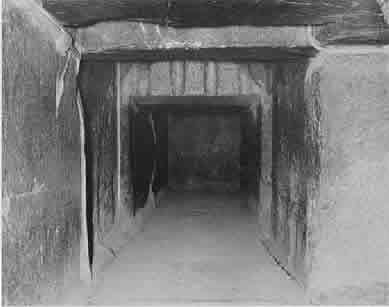
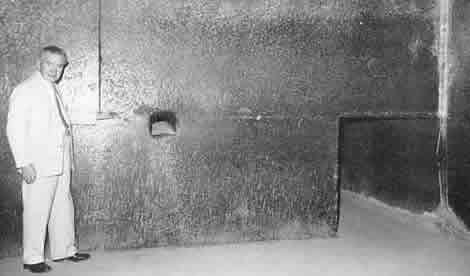 At the top of the Grand Gallery lies a huge stone step which measures 6 feet wide by 3 feet high.
It forms a platform 8 feet deep. It is very worn and chipped. Past the Great Step is another low,
horizontal passage 41 inches square which leads to the King's chamber. A third of a way along this passage,
it rises and widens into a sort of antechamber, the south, east and west walls of which are no longer limestone
but red granite. The King’s chamber, made out of granite, measures about 34 feet by 17 feet and is about 19 feet
high. The picture on the right shows where the passage enters the chamber (right hand opening) and the air shaft
(or water outlet), 42" above the floor level.
At the top of the Grand Gallery lies a huge stone step which measures 6 feet wide by 3 feet high.
It forms a platform 8 feet deep. It is very worn and chipped. Past the Great Step is another low,
horizontal passage 41 inches square which leads to the King's chamber. A third of a way along this passage,
it rises and widens into a sort of antechamber, the south, east and west walls of which are no longer limestone
but red granite. The King’s chamber, made out of granite, measures about 34 feet by 17 feet and is about 19 feet
high. The picture on the right shows where the passage enters the chamber (right hand opening) and the air shaft
(or water outlet), 42" above the floor level.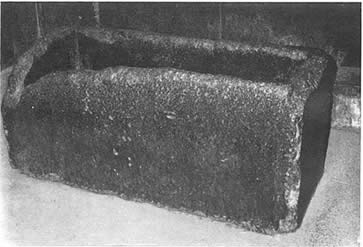 The only thing found in this chamber ia a large lidless coffin or coffer, of highly polished granite This
beautiful granite box was made from a solid block of chocolate-colored granite and is even harder than the
granite walls of the King's Chamber. It is 89.8 inches long, 38.7 inches wide and 41.2 inches high, really too
large to have been brought in through the passages; it is assumed it was put there by the original builders.
There is evidence it once had a sliding lid, but this box has suffered a lot from 'tourist' and 'researcher'
pressure. The box is not part of the floor. It is quite probable that there was a lid, slotted to allow water
to flow through the contents of the box. The contents would have been a clarifying agent, a precipitant, which
would help precipitate out particles suspended in the water, similar to modern water treatment plants.
The material would have been replaced or renewed during regular maintenence routines. A simple example of this
is the use of crushed eggshells to clarify boiled coffee grounds ('camp coffee')
The only thing found in this chamber ia a large lidless coffin or coffer, of highly polished granite This
beautiful granite box was made from a solid block of chocolate-colored granite and is even harder than the
granite walls of the King's Chamber. It is 89.8 inches long, 38.7 inches wide and 41.2 inches high, really too
large to have been brought in through the passages; it is assumed it was put there by the original builders.
There is evidence it once had a sliding lid, but this box has suffered a lot from 'tourist' and 'researcher'
pressure. The box is not part of the floor. It is quite probable that there was a lid, slotted to allow water
to flow through the contents of the box. The contents would have been a clarifying agent, a precipitant, which
would help precipitate out particles suspended in the water, similar to modern water treatment plants.
The material would have been replaced or renewed during regular maintenence routines. A simple example of this
is the use of crushed eggshells to clarify boiled coffee grounds ('camp coffee')
